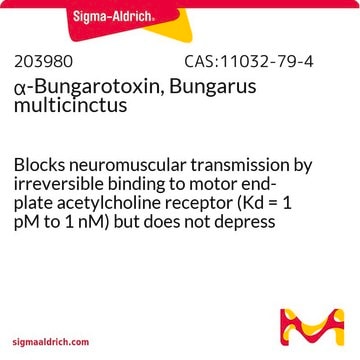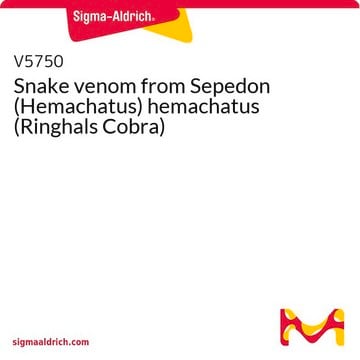T0195
α-Bungarotoxin-tetramethylrhodamine from Bungarus multicinctus (Formosan Banded Krait)
Synonym(e):
TMR-α-BTX
Anmeldenzur Ansicht organisationsspezifischer und vertraglich vereinbarter Preise
Alle Fotos(1)
About This Item
Empfohlene Produkte
Anwendung
α-Bungarotoxin-tetramethylrhodamine from Bungarus multicinctus was used at a dilution of 1:220 to identify the distribution of nicotinic acetylcholine receptors at neuromuscular junctions of longitudinal sections of rat gastrocnemius muscle.
α-Bungarotoxin-tetramethylrhodamine from Bungarus multicinctus (Formosan Banded Krait) has been used in immunofluorescence staining (1:200) for identification of neuromuscular junction in experimental models. It has also been used to block muscle contraction in myotome cells.
Biochem./physiol. Wirkung
α-Bungarotoxin is a high-affinity antagonist for nicotinic acetylcholine receptors (AChRs) from muscle but not the neurons. Labeling α-Bungarotoxin with tetramethylrhodamine enables the detection of bungarotoxin-binding receptors at neuromuscular junctions.
Useful for detecting the distribution of nicotinic acetylcholine receptors at neuromuscular junctions.
Lagerklassenschlüssel
11 - Combustible Solids
WGK
WGK 3
Flammpunkt (°F)
Not applicable
Flammpunkt (°C)
Not applicable
Persönliche Schutzausrüstung
Eyeshields, Gloves, type N95 (US)
Analysenzertifikate (COA)
Suchen Sie nach Analysenzertifikate (COA), indem Sie die Lot-/Chargennummer des Produkts eingeben. Lot- und Chargennummern sind auf dem Produktetikett hinter den Wörtern ‘Lot’ oder ‘Batch’ (Lot oder Charge) zu finden.
Besitzen Sie dieses Produkt bereits?
In der Dokumentenbibliothek finden Sie die Dokumentation zu den Produkten, die Sie kürzlich erworben haben.
Kunden haben sich ebenfalls angesehen
Young-Tae Kim et al.
Biomaterials, 29(21), 3117-3127 (2008-05-02)
Peripheral nerve regeneration across long nerve gaps is clinically challenging. Autografts, the standard of therapy, are limited by availability and other complications. Here, using rigorous anatomical and functional measures, we report that aligned polymer fiber-based constructs present topographical cues that
Matthew A White et al.
Acta neuropathologica communications, 7(1), 166-166 (2019-10-30)
Amyotrophic lateral sclerosis (ALS) is a fatal neurodegenerative condition that primarily affects the motor system and shares many features with frontotemporal dementia (FTD). Evidence suggests that ALS is a 'dying-back' disease, with peripheral denervation and axonal degeneration occurring before loss
Sara Bachiller et al.
Molecular neurobiology, 55(12), 8856-8868 (2018-04-01)
A missense mutation in HERC1 provokes loss of cerebellar Purkinje cells, tremor, and unstable gait in tambaleante (tbl) mice. Recently, we have shown that before cerebellar degeneration takes place, the tbl mouse suffers from a reduction in the number of
Brian T Feeley et al.
The American journal of sports medicine, 48(11), 2660-2668 (2020-07-31)
The muscle quality of the rotator cuff (RC), measured by atrophy and fatty infiltration (FI), is a key determinant of outcomes in RC injury and repair. The ability to regenerate muscle after repair has been shown to be limited. To
Paul Hendrickse et al.
Experimental gerontology, 106, 159-164 (2018-03-11)
A large part of age-related muscle wasting is due to incomplete reinnervation of fibres that have become denervated following motoneuron loss. Neural cell adhesion molecule (NCAM) and sodium channel NaV1.5 are considered markers for denervation, but the time course of
Unser Team von Wissenschaftlern verfügt über Erfahrung in allen Forschungsbereichen einschließlich Life Science, Materialwissenschaften, chemischer Synthese, Chromatographie, Analytik und vielen mehr..
Setzen Sie sich mit dem technischen Dienst in Verbindung.









